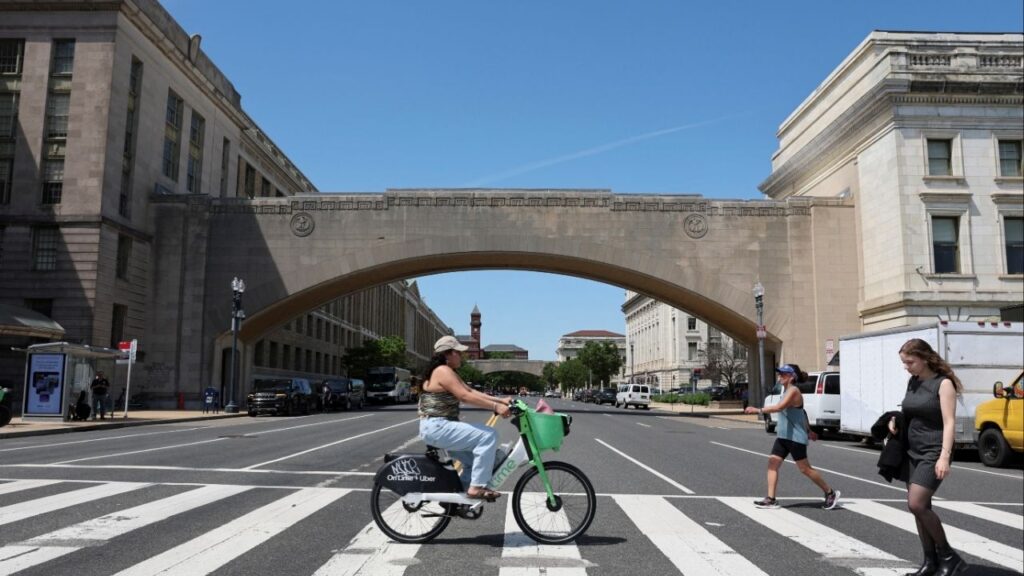Share

Ben Christopher
CalMatters

Julie Cart
CalMatters
After months of debate and two postponed votes, California’s utility regulator unanimously voted today to overhaul incentives for owners of apartment buildings, schools and businesses that install solar panels.
The new regulations are the second major step that the California Public Utilities Commission has taken in the past year to reduce power companies’ financial support for rooftop solar. In December, the commission reduced payments to homeowners who sell excess power from newly installed solar panels on single-family homes.
Still, for solar advocates, it could have been worse.
Thanks to a last-minute regulatory tweak, the new rules today stop short of a previous proposal that solar industry groups and housing-related interests warned would result in the “evisceration” of the multifamily solar market.
Under the new rules, apartment buildings, schools, farms, commercial strips and other facilities where multiple electric meters occupy the same site will receive significantly less money from utilities in exchange for the excess solar energy they produce and sell back. These customers would be paid about 80% less per unit of energy they sell, solar advocates say.
“This forces them to sell low and buy high,” said Bernadette Del Chiaro, executive director of the California Solar & Storage Association, which led the campaign against the rule change. “No one is going to go solar under that setup.”
The reduced incentives will apply immediately to new solar customers or arrays. Older units will be gradually phased in over the next 20 years. The commission also emphasized that existing rates would remain for those enrolled in affordable housing programs.
The commission said it altered the rates because paying solar panel owners near-retail prices allows these mostly wealthy property owners to avoid paying a fair share of maintaining the grid.
The new solar payments come at the same time that California is trying to stop using fossil fuels to produce energy, with a state goal of 100% carbon-free electricity by 2045. By then, the state projects that more than half of California’s power will come from large-scale and rooftop solar.
The regulatory overhaul was endorsed by the state’s investor-owned utilities, Pacific Gas & Electric, Southern California Edison and San Diego Gas & Electric Company.
The commission said it altered the rates because paying solar panel owners near-retail prices allows these mostly wealthy property owners to avoid paying a fair share of maintaining the grid, while saddling everyone else with higher electric bills, including low-income customers.
Commission President Alice Reynolds said the decision would reduce a subsidy that burdened other ratepayers. She called the decision a culmination of a “complex and long process” and said it would modernize the rate system while providing incentives for new solar customers to add battery storage, critical for maintaining grid reliability, she said.
The five commissioners sat stone-faced during a barrage of criticism at the 90-minute public comment session that opened the meeting in El Centro. Some people let loose on commissioners regarding the solar proposal, calling them a disgrace, in the thrall of utility companies and saying they should be ashamed of themselves.
One commenter from the Los Angeles Unified School District said if the new rules are adopted it would make it difficult for the district to meet its climate goals to operate on 100% renewable energy.
In a concession to months of lobbying from the solar industry and its allies, the commission opted to let multifamily housing residents directly consume the solar power they generate, rather than force them to sell it in bulk to utilities. Allowing this “self-consumption” boosts the financial value of a solar array by letting residents offset high retail rates.
It’s a victory for rooftop solar advocates — but it only applies to residences so commercial, agricultural and school sites hoping for future solar savings are still out of luck.
Rooftop solar advocates called the new rule an improvement over the previous proposal. But they aren’t exactly applauding today’s vote either.
Utilities, which have backed the regulatory re-do from the start and had spent months arguing against a self-consumption provision, nevertheless embraced the new rule as a compromise they’re willing to live with.
“Generally positive” is how Gabriela Ornelas, a spokesperson for Southern California Edison, described it. She said the new rules ensure that the system “will benefit renters.”
Rooftop solar advocates called the new rule an improvement over the previous proposal. But they aren’t exactly applauding today’s vote either.
“It’s sort of a half loaf, or, more like a fraction of a loaf,” Del Chiaro said. “It’s still really messing with the economics of solar for multifamily housing.”
The changes were made in what the commission calls “Virtual Net Energy Metering,” or VNEM, and “Net Energy Metering Aggregation,” or NEMA. Those rules set out how much utilities pay customers for the excess energy from solar installations they feed into the grid.
First Houses, Now Apartments
Today’s ruling is a regulatory sequel.
Rewind to the summer of 2022: Single family homeowners with solar panels were paid a fixed price for any home-made solar power. The prices they received were close to the retail rate for electricity.
Last winter, the Public Utilities Commission did away with that, replacing it with a flexible rate that amounted to a massive pay cut for solar-producing single family homeowners, trimming compensation by roughly 75%. The new rate applies only to new installations, not existing solar arrays. At the same time, the commission funded $900 million in new incentive payments to single family home residents to help them purchase new systems.
For multi-unit apartments, schools and businesses, the new rate structure will apply immediately only to new solar customers. Building owners that already have arrays on their roofs get a more gradual phase-in with a guaranteed 20 years under the old rules. For example, a customer that went solar five years ago won’t have to switch over to the new rate system for another 15 years. Customers that have signed up since April of this year, many of whom are still waiting to be connected to the grid, get a shorter nine-year “legacy” period.
What ‘Self-Consumption’ Means to Ratepayers
The commission tasked itself with developing a policy for multiplexes, apartments and other multi-meter properties but ran into a problem: self-consumption.
Under the new pricing system for single-family households enacted in winter of 2022, homeowners can still use the solar electricity they generate, forgoing the high retail prices that utilities would otherwise charge them. That can add up to significant savings.
But when the commission put out an early proposal for the apartment rule, they didn’t extend that same provision to apartment owners: Every electron produced by a building’s solar array would have to be sold back to the grid at the new lower, variable prices. Electricity consumed by an apartment dweller would have to be purchased from the utility at retail prices. The commission argued, in part, that divvying up the value of solar across multiple accounts would be too complicated for utilities to administer, regulators to police and customers to understand.
But the rooftop solar industry saw it as an existential threat. No self-consumption meant a lower financial return from “going solar.” Ivy Energy, a San Diego-based solar software company, warned that the policy, if enacted, would “result in a collapse of the multifamily solar market.”
That prospect unleashed a lobbying blitz from rooftop solar trade groups. They were joined by other organizations interested in preserving higher compensation rates for apartment owners and their tenants. Building industry groups and landlords complained that while state regulations already require solar panels to top new buildings, this new rule would make those panels a money pit. Affordable housing developers and renter rights advocates joined in, warning that with the electrification of cars, stoves and heaters, solar savings were one of the few checks on skyrocketing electric bills for lower income renters.
The new rule “is still really messing with the economics of solar for multifamily housing.”
Bernadette Del Chiaro, California Solar & Storage Association
The rules also caught the attention of farmers, school districts and commercial stripmall tenants, all of which tend to occupy multi-meter properties.
This outcry drove the changes in the proposal to allow self-consumption for apartment dwellers.
However, under the new rules, any wired part of a housing site that isn’t paid through a resident’s electric bill will not qualify for self-consumption of solar power. That includes common areas, like lobbies and garages, as well as any shops that might coexist alongside lofts in mixed-use buildings.
This exemption for the “nonresidential” portions of housing developments has builders and some environmentally-minded tenant rights groups especially irked. Whether it’s a heat pump water heater or a charging station for electric cars, most of the major upgrades required to decarbonize electricity in multifamily buildings are in common spaces.
“If the (the commission) doesn’t allow property owners to affordably power those chargers with self-generation, California will see far fewer renters with EVs,” warned Alfred Twu, secretary of the California Democratic Renters Council, in a letter to the commission. “Asking customers to add large electric loads while blocking them from generating their own power for those loads would be a policy failure.”
About the Authors
Ben covers housing policy and previously covered California politics and elections. Prior to these roles at CalMatters, he was a contributing writer for CalMatters reporting on the state’s economy and budget. Based out of the San Francisco Bay Area, he has written for San Francisco magazine, California magazine, the San Francisco Chronicle, and Priceonomics. Ben also has a past life as an aspiring beancounter: He has worked as a summer associate at the Congressional Budget Office and has a Master’s in Public Policy from the University of California, Berkeley.
Julie Cart joined CalMatters as a projects and environment reporter in 2016 after a long career at the Los Angeles Times, where she held many positions: sportswriter, national correspondent and environment reporter. In 2009 she and colleague Bettina Boxall won the Pulitzer Prize for Explanatory Reporting for their series on wildfires in the West.
About CalMatters
CalMatters is a nonprofit, nonpartisan newsroom committed to explaining California policy and politics.
RELATED TOPICS:
Categories

Fresno Police Arrest Suspect in October Shooting

















